University of Northampton MKTM028: Marketing Orientation Essay
VerifiedAdded on 2022/10/14
|8
|2781
|103
Essay
AI Summary
This essay delves into the concept of marketing orientation, a core principle in strategic marketing. It critically evaluates the perspective that marketing orientation encompasses customer orientation, competitor orientation, interfunctional coordination, organizational culture, and long-term shareholder value creation. The essay explores these components in detail, drawing upon academic literature to compare and contrast marketing orientation with other business orientations, such as production and sales orientations. It examines how businesses can effectively integrate these elements to create superior value for customers, understand competitor capabilities, align internal resources, and foster a culture that prioritizes customer satisfaction, ultimately leading to enhanced shareholder value. The analysis covers various marketing strategies, including business-to-business and business-to-consumer approaches, and the importance of customer relationship management and competitive analysis within the dynamic business environment. The essay also discusses organizational marketing, the role of inter-functional coordination, and the impact of organizational behavior on marketing success.
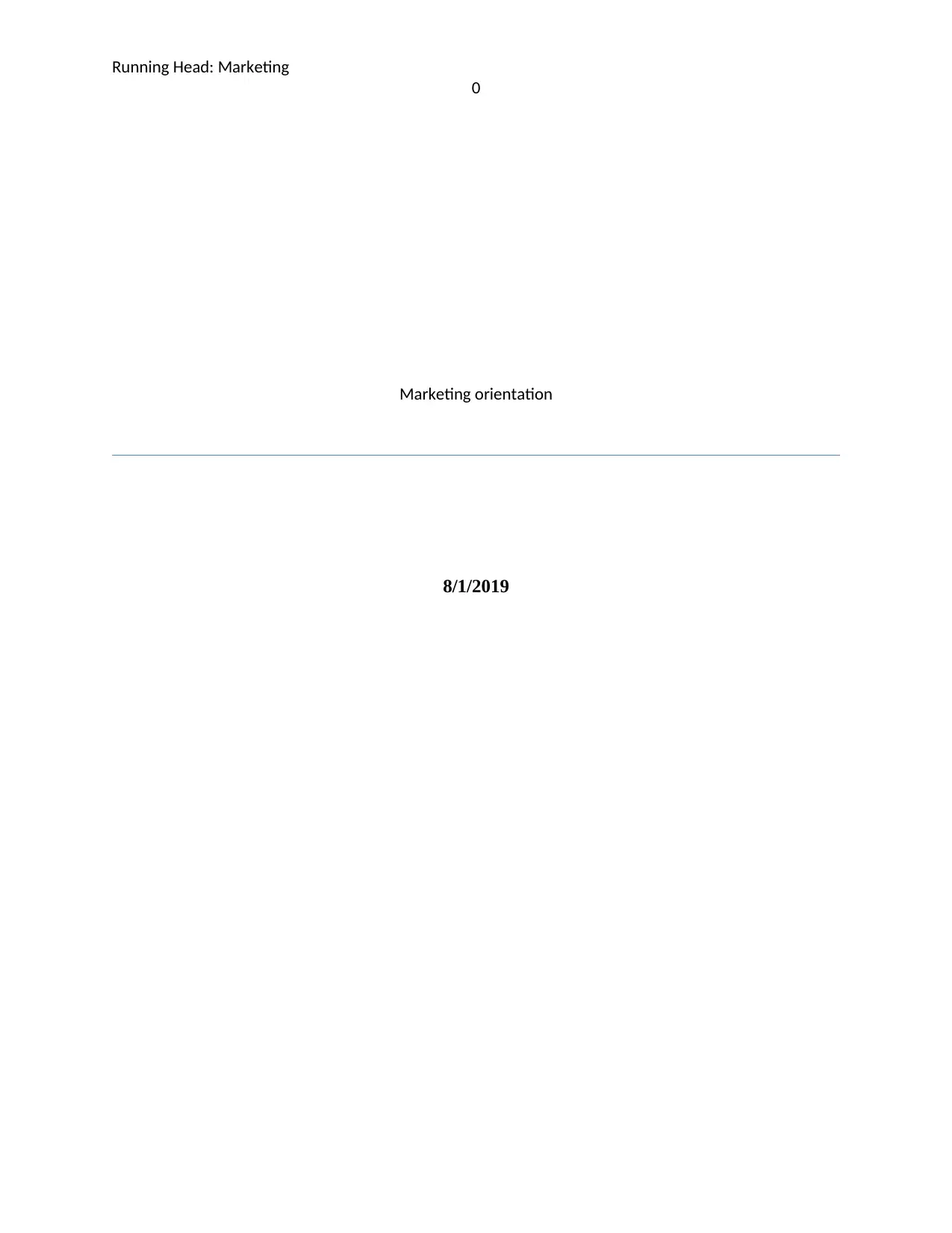
Running Head: Marketing
0
Marketing orientation
8/1/2019
0
Marketing orientation
8/1/2019
Paraphrase This Document
Need a fresh take? Get an instant paraphrase of this document with our AI Paraphraser
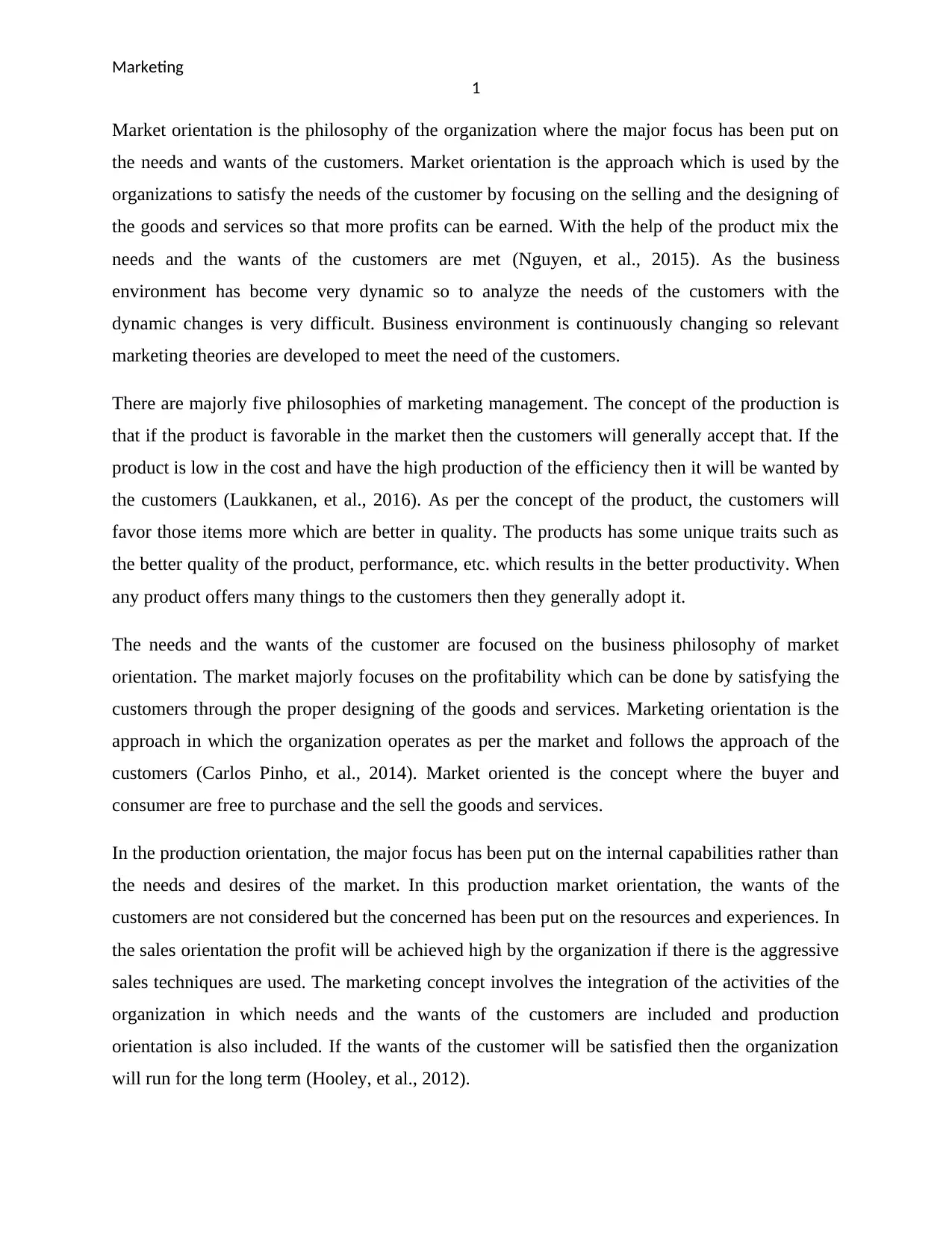
Marketing
1
Market orientation is the philosophy of the organization where the major focus has been put on
the needs and wants of the customers. Market orientation is the approach which is used by the
organizations to satisfy the needs of the customer by focusing on the selling and the designing of
the goods and services so that more profits can be earned. With the help of the product mix the
needs and the wants of the customers are met (Nguyen, et al., 2015). As the business
environment has become very dynamic so to analyze the needs of the customers with the
dynamic changes is very difficult. Business environment is continuously changing so relevant
marketing theories are developed to meet the need of the customers.
There are majorly five philosophies of marketing management. The concept of the production is
that if the product is favorable in the market then the customers will generally accept that. If the
product is low in the cost and have the high production of the efficiency then it will be wanted by
the customers (Laukkanen, et al., 2016). As per the concept of the product, the customers will
favor those items more which are better in quality. The products has some unique traits such as
the better quality of the product, performance, etc. which results in the better productivity. When
any product offers many things to the customers then they generally adopt it.
The needs and the wants of the customer are focused on the business philosophy of market
orientation. The market majorly focuses on the profitability which can be done by satisfying the
customers through the proper designing of the goods and services. Marketing orientation is the
approach in which the organization operates as per the market and follows the approach of the
customers (Carlos Pinho, et al., 2014). Market oriented is the concept where the buyer and
consumer are free to purchase and the sell the goods and services.
In the production orientation, the major focus has been put on the internal capabilities rather than
the needs and desires of the market. In this production market orientation, the wants of the
customers are not considered but the concerned has been put on the resources and experiences. In
the sales orientation the profit will be achieved high by the organization if there is the aggressive
sales techniques are used. The marketing concept involves the integration of the activities of the
organization in which needs and the wants of the customers are included and production
orientation is also included. If the wants of the customer will be satisfied then the organization
will run for the long term (Hooley, et al., 2012).
1
Market orientation is the philosophy of the organization where the major focus has been put on
the needs and wants of the customers. Market orientation is the approach which is used by the
organizations to satisfy the needs of the customer by focusing on the selling and the designing of
the goods and services so that more profits can be earned. With the help of the product mix the
needs and the wants of the customers are met (Nguyen, et al., 2015). As the business
environment has become very dynamic so to analyze the needs of the customers with the
dynamic changes is very difficult. Business environment is continuously changing so relevant
marketing theories are developed to meet the need of the customers.
There are majorly five philosophies of marketing management. The concept of the production is
that if the product is favorable in the market then the customers will generally accept that. If the
product is low in the cost and have the high production of the efficiency then it will be wanted by
the customers (Laukkanen, et al., 2016). As per the concept of the product, the customers will
favor those items more which are better in quality. The products has some unique traits such as
the better quality of the product, performance, etc. which results in the better productivity. When
any product offers many things to the customers then they generally adopt it.
The needs and the wants of the customer are focused on the business philosophy of market
orientation. The market majorly focuses on the profitability which can be done by satisfying the
customers through the proper designing of the goods and services. Marketing orientation is the
approach in which the organization operates as per the market and follows the approach of the
customers (Carlos Pinho, et al., 2014). Market oriented is the concept where the buyer and
consumer are free to purchase and the sell the goods and services.
In the production orientation, the major focus has been put on the internal capabilities rather than
the needs and desires of the market. In this production market orientation, the wants of the
customers are not considered but the concerned has been put on the resources and experiences. In
the sales orientation the profit will be achieved high by the organization if there is the aggressive
sales techniques are used. The marketing concept involves the integration of the activities of the
organization in which needs and the wants of the customers are included and production
orientation is also included. If the wants of the customer will be satisfied then the organization
will run for the long term (Hooley, et al., 2012).
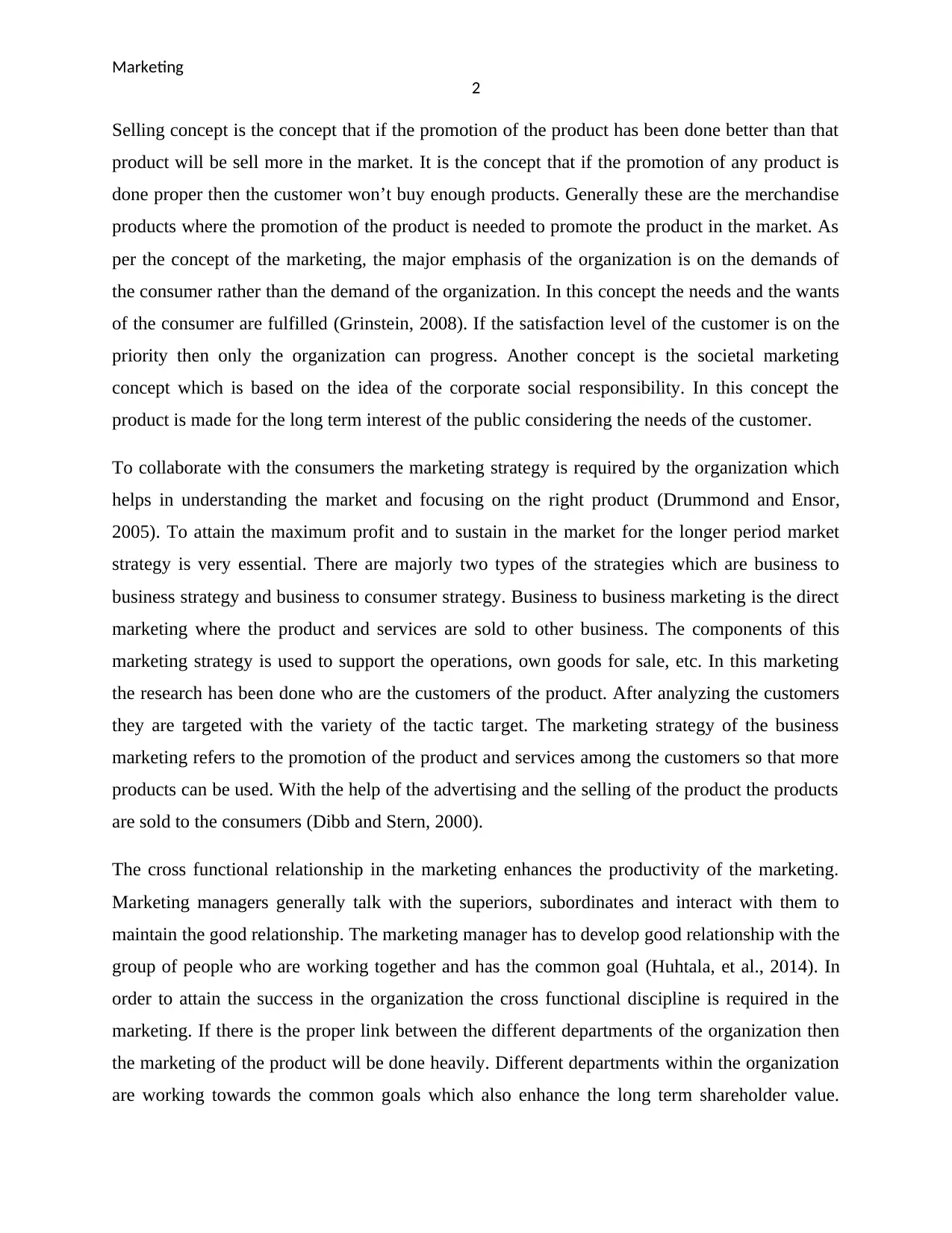
Marketing
2
Selling concept is the concept that if the promotion of the product has been done better than that
product will be sell more in the market. It is the concept that if the promotion of any product is
done proper then the customer won’t buy enough products. Generally these are the merchandise
products where the promotion of the product is needed to promote the product in the market. As
per the concept of the marketing, the major emphasis of the organization is on the demands of
the consumer rather than the demand of the organization. In this concept the needs and the wants
of the consumer are fulfilled (Grinstein, 2008). If the satisfaction level of the customer is on the
priority then only the organization can progress. Another concept is the societal marketing
concept which is based on the idea of the corporate social responsibility. In this concept the
product is made for the long term interest of the public considering the needs of the customer.
To collaborate with the consumers the marketing strategy is required by the organization which
helps in understanding the market and focusing on the right product (Drummond and Ensor,
2005). To attain the maximum profit and to sustain in the market for the longer period market
strategy is very essential. There are majorly two types of the strategies which are business to
business strategy and business to consumer strategy. Business to business marketing is the direct
marketing where the product and services are sold to other business. The components of this
marketing strategy is used to support the operations, own goods for sale, etc. In this marketing
the research has been done who are the customers of the product. After analyzing the customers
they are targeted with the variety of the tactic target. The marketing strategy of the business
marketing refers to the promotion of the product and services among the customers so that more
products can be used. With the help of the advertising and the selling of the product the products
are sold to the consumers (Dibb and Stern, 2000).
The cross functional relationship in the marketing enhances the productivity of the marketing.
Marketing managers generally talk with the superiors, subordinates and interact with them to
maintain the good relationship. The marketing manager has to develop good relationship with the
group of people who are working together and has the common goal (Huhtala, et al., 2014). In
order to attain the success in the organization the cross functional discipline is required in the
marketing. If there is the proper link between the different departments of the organization then
the marketing of the product will be done heavily. Different departments within the organization
are working towards the common goals which also enhance the long term shareholder value.
2
Selling concept is the concept that if the promotion of the product has been done better than that
product will be sell more in the market. It is the concept that if the promotion of any product is
done proper then the customer won’t buy enough products. Generally these are the merchandise
products where the promotion of the product is needed to promote the product in the market. As
per the concept of the marketing, the major emphasis of the organization is on the demands of
the consumer rather than the demand of the organization. In this concept the needs and the wants
of the consumer are fulfilled (Grinstein, 2008). If the satisfaction level of the customer is on the
priority then only the organization can progress. Another concept is the societal marketing
concept which is based on the idea of the corporate social responsibility. In this concept the
product is made for the long term interest of the public considering the needs of the customer.
To collaborate with the consumers the marketing strategy is required by the organization which
helps in understanding the market and focusing on the right product (Drummond and Ensor,
2005). To attain the maximum profit and to sustain in the market for the longer period market
strategy is very essential. There are majorly two types of the strategies which are business to
business strategy and business to consumer strategy. Business to business marketing is the direct
marketing where the product and services are sold to other business. The components of this
marketing strategy is used to support the operations, own goods for sale, etc. In this marketing
the research has been done who are the customers of the product. After analyzing the customers
they are targeted with the variety of the tactic target. The marketing strategy of the business
marketing refers to the promotion of the product and services among the customers so that more
products can be used. With the help of the advertising and the selling of the product the products
are sold to the consumers (Dibb and Stern, 2000).
The cross functional relationship in the marketing enhances the productivity of the marketing.
Marketing managers generally talk with the superiors, subordinates and interact with them to
maintain the good relationship. The marketing manager has to develop good relationship with the
group of people who are working together and has the common goal (Huhtala, et al., 2014). In
order to attain the success in the organization the cross functional discipline is required in the
marketing. If there is the proper link between the different departments of the organization then
the marketing of the product will be done heavily. Different departments within the organization
are working towards the common goals which also enhance the long term shareholder value.
⊘ This is a preview!⊘
Do you want full access?
Subscribe today to unlock all pages.

Trusted by 1+ million students worldwide
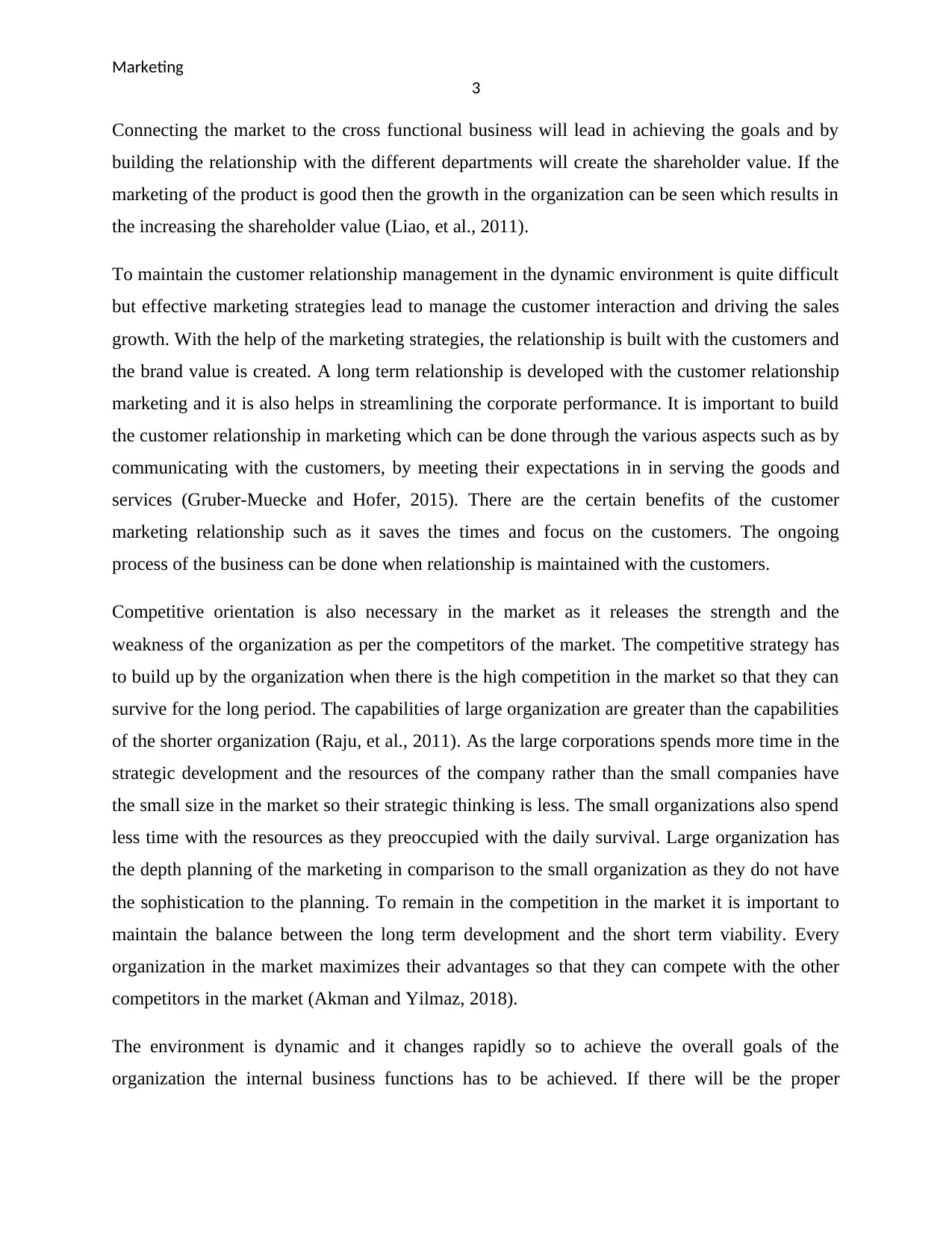
Marketing
3
Connecting the market to the cross functional business will lead in achieving the goals and by
building the relationship with the different departments will create the shareholder value. If the
marketing of the product is good then the growth in the organization can be seen which results in
the increasing the shareholder value (Liao, et al., 2011).
To maintain the customer relationship management in the dynamic environment is quite difficult
but effective marketing strategies lead to manage the customer interaction and driving the sales
growth. With the help of the marketing strategies, the relationship is built with the customers and
the brand value is created. A long term relationship is developed with the customer relationship
marketing and it is also helps in streamlining the corporate performance. It is important to build
the customer relationship in marketing which can be done through the various aspects such as by
communicating with the customers, by meeting their expectations in in serving the goods and
services (Gruber-Muecke and Hofer, 2015). There are the certain benefits of the customer
marketing relationship such as it saves the times and focus on the customers. The ongoing
process of the business can be done when relationship is maintained with the customers.
Competitive orientation is also necessary in the market as it releases the strength and the
weakness of the organization as per the competitors of the market. The competitive strategy has
to build up by the organization when there is the high competition in the market so that they can
survive for the long period. The capabilities of large organization are greater than the capabilities
of the shorter organization (Raju, et al., 2011). As the large corporations spends more time in the
strategic development and the resources of the company rather than the small companies have
the small size in the market so their strategic thinking is less. The small organizations also spend
less time with the resources as they preoccupied with the daily survival. Large organization has
the depth planning of the marketing in comparison to the small organization as they do not have
the sophistication to the planning. To remain in the competition in the market it is important to
maintain the balance between the long term development and the short term viability. Every
organization in the market maximizes their advantages so that they can compete with the other
competitors in the market (Akman and Yilmaz, 2018).
The environment is dynamic and it changes rapidly so to achieve the overall goals of the
organization the internal business functions has to be achieved. If there will be the proper
3
Connecting the market to the cross functional business will lead in achieving the goals and by
building the relationship with the different departments will create the shareholder value. If the
marketing of the product is good then the growth in the organization can be seen which results in
the increasing the shareholder value (Liao, et al., 2011).
To maintain the customer relationship management in the dynamic environment is quite difficult
but effective marketing strategies lead to manage the customer interaction and driving the sales
growth. With the help of the marketing strategies, the relationship is built with the customers and
the brand value is created. A long term relationship is developed with the customer relationship
marketing and it is also helps in streamlining the corporate performance. It is important to build
the customer relationship in marketing which can be done through the various aspects such as by
communicating with the customers, by meeting their expectations in in serving the goods and
services (Gruber-Muecke and Hofer, 2015). There are the certain benefits of the customer
marketing relationship such as it saves the times and focus on the customers. The ongoing
process of the business can be done when relationship is maintained with the customers.
Competitive orientation is also necessary in the market as it releases the strength and the
weakness of the organization as per the competitors of the market. The competitive strategy has
to build up by the organization when there is the high competition in the market so that they can
survive for the long period. The capabilities of large organization are greater than the capabilities
of the shorter organization (Raju, et al., 2011). As the large corporations spends more time in the
strategic development and the resources of the company rather than the small companies have
the small size in the market so their strategic thinking is less. The small organizations also spend
less time with the resources as they preoccupied with the daily survival. Large organization has
the depth planning of the marketing in comparison to the small organization as they do not have
the sophistication to the planning. To remain in the competition in the market it is important to
maintain the balance between the long term development and the short term viability. Every
organization in the market maximizes their advantages so that they can compete with the other
competitors in the market (Akman and Yilmaz, 2018).
The environment is dynamic and it changes rapidly so to achieve the overall goals of the
organization the internal business functions has to be achieved. If there will be the proper
Paraphrase This Document
Need a fresh take? Get an instant paraphrase of this document with our AI Paraphraser
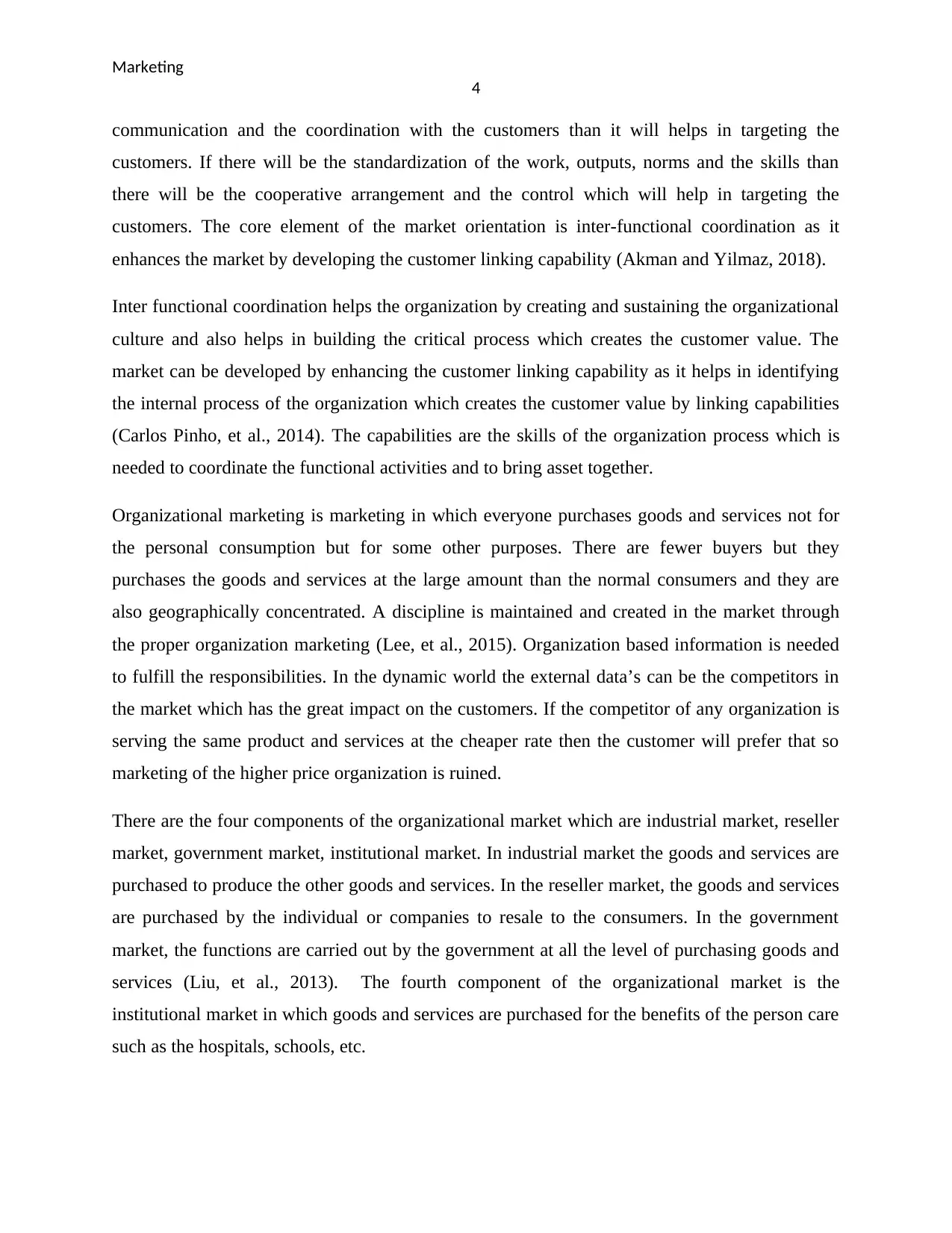
Marketing
4
communication and the coordination with the customers than it will helps in targeting the
customers. If there will be the standardization of the work, outputs, norms and the skills than
there will be the cooperative arrangement and the control which will help in targeting the
customers. The core element of the market orientation is inter-functional coordination as it
enhances the market by developing the customer linking capability (Akman and Yilmaz, 2018).
Inter functional coordination helps the organization by creating and sustaining the organizational
culture and also helps in building the critical process which creates the customer value. The
market can be developed by enhancing the customer linking capability as it helps in identifying
the internal process of the organization which creates the customer value by linking capabilities
(Carlos Pinho, et al., 2014). The capabilities are the skills of the organization process which is
needed to coordinate the functional activities and to bring asset together.
Organizational marketing is marketing in which everyone purchases goods and services not for
the personal consumption but for some other purposes. There are fewer buyers but they
purchases the goods and services at the large amount than the normal consumers and they are
also geographically concentrated. A discipline is maintained and created in the market through
the proper organization marketing (Lee, et al., 2015). Organization based information is needed
to fulfill the responsibilities. In the dynamic world the external data’s can be the competitors in
the market which has the great impact on the customers. If the competitor of any organization is
serving the same product and services at the cheaper rate then the customer will prefer that so
marketing of the higher price organization is ruined.
There are the four components of the organizational market which are industrial market, reseller
market, government market, institutional market. In industrial market the goods and services are
purchased to produce the other goods and services. In the reseller market, the goods and services
are purchased by the individual or companies to resale to the consumers. In the government
market, the functions are carried out by the government at all the level of purchasing goods and
services (Liu, et al., 2013). The fourth component of the organizational market is the
institutional market in which goods and services are purchased for the benefits of the person care
such as the hospitals, schools, etc.
4
communication and the coordination with the customers than it will helps in targeting the
customers. If there will be the standardization of the work, outputs, norms and the skills than
there will be the cooperative arrangement and the control which will help in targeting the
customers. The core element of the market orientation is inter-functional coordination as it
enhances the market by developing the customer linking capability (Akman and Yilmaz, 2018).
Inter functional coordination helps the organization by creating and sustaining the organizational
culture and also helps in building the critical process which creates the customer value. The
market can be developed by enhancing the customer linking capability as it helps in identifying
the internal process of the organization which creates the customer value by linking capabilities
(Carlos Pinho, et al., 2014). The capabilities are the skills of the organization process which is
needed to coordinate the functional activities and to bring asset together.
Organizational marketing is marketing in which everyone purchases goods and services not for
the personal consumption but for some other purposes. There are fewer buyers but they
purchases the goods and services at the large amount than the normal consumers and they are
also geographically concentrated. A discipline is maintained and created in the market through
the proper organization marketing (Lee, et al., 2015). Organization based information is needed
to fulfill the responsibilities. In the dynamic world the external data’s can be the competitors in
the market which has the great impact on the customers. If the competitor of any organization is
serving the same product and services at the cheaper rate then the customer will prefer that so
marketing of the higher price organization is ruined.
There are the four components of the organizational market which are industrial market, reseller
market, government market, institutional market. In industrial market the goods and services are
purchased to produce the other goods and services. In the reseller market, the goods and services
are purchased by the individual or companies to resale to the consumers. In the government
market, the functions are carried out by the government at all the level of purchasing goods and
services (Liu, et al., 2013). The fourth component of the organizational market is the
institutional market in which goods and services are purchased for the benefits of the person care
such as the hospitals, schools, etc.
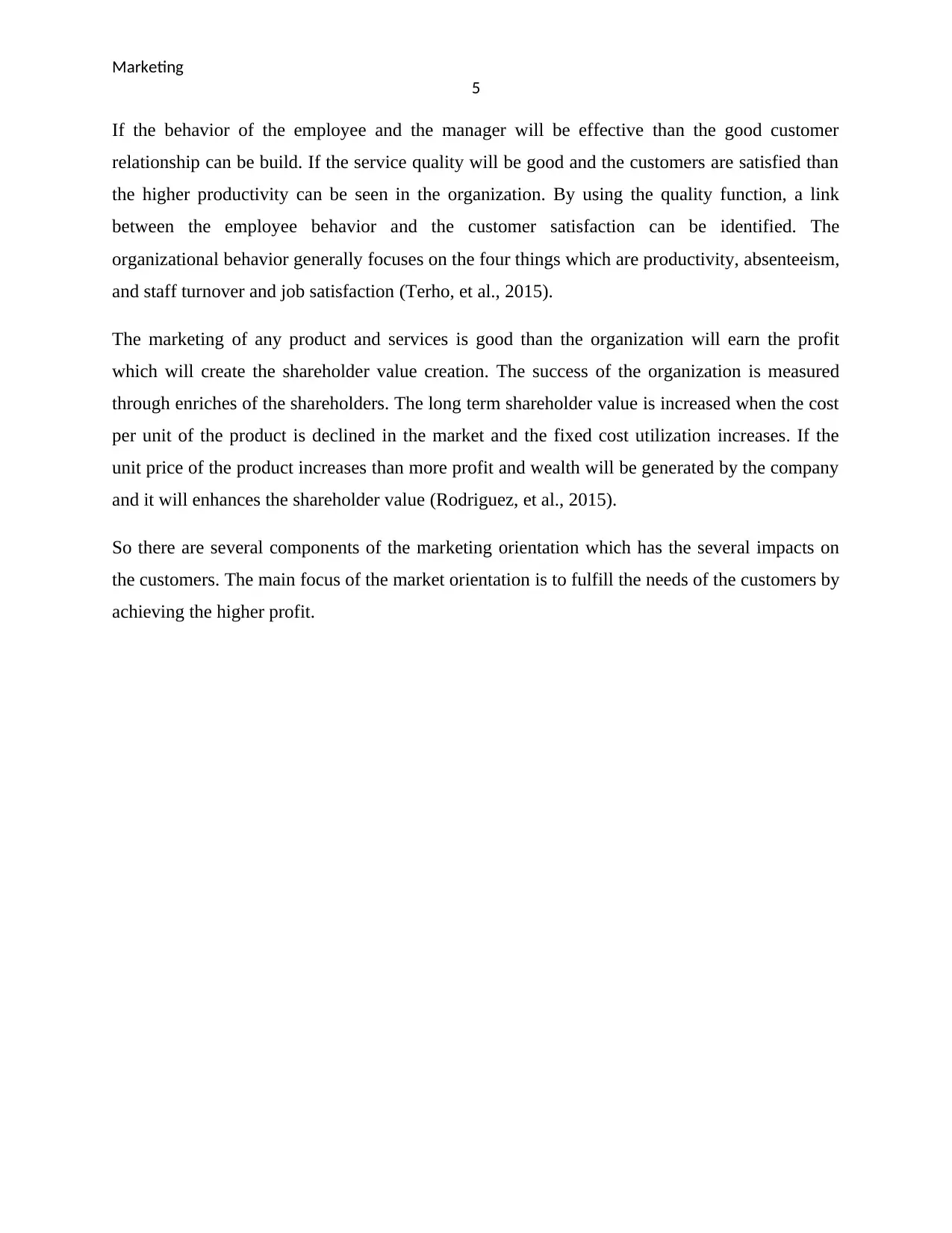
Marketing
5
If the behavior of the employee and the manager will be effective than the good customer
relationship can be build. If the service quality will be good and the customers are satisfied than
the higher productivity can be seen in the organization. By using the quality function, a link
between the employee behavior and the customer satisfaction can be identified. The
organizational behavior generally focuses on the four things which are productivity, absenteeism,
and staff turnover and job satisfaction (Terho, et al., 2015).
The marketing of any product and services is good than the organization will earn the profit
which will create the shareholder value creation. The success of the organization is measured
through enriches of the shareholders. The long term shareholder value is increased when the cost
per unit of the product is declined in the market and the fixed cost utilization increases. If the
unit price of the product increases than more profit and wealth will be generated by the company
and it will enhances the shareholder value (Rodriguez, et al., 2015).
So there are several components of the marketing orientation which has the several impacts on
the customers. The main focus of the market orientation is to fulfill the needs of the customers by
achieving the higher profit.
5
If the behavior of the employee and the manager will be effective than the good customer
relationship can be build. If the service quality will be good and the customers are satisfied than
the higher productivity can be seen in the organization. By using the quality function, a link
between the employee behavior and the customer satisfaction can be identified. The
organizational behavior generally focuses on the four things which are productivity, absenteeism,
and staff turnover and job satisfaction (Terho, et al., 2015).
The marketing of any product and services is good than the organization will earn the profit
which will create the shareholder value creation. The success of the organization is measured
through enriches of the shareholders. The long term shareholder value is increased when the cost
per unit of the product is declined in the market and the fixed cost utilization increases. If the
unit price of the product increases than more profit and wealth will be generated by the company
and it will enhances the shareholder value (Rodriguez, et al., 2015).
So there are several components of the marketing orientation which has the several impacts on
the customers. The main focus of the market orientation is to fulfill the needs of the customers by
achieving the higher profit.
⊘ This is a preview!⊘
Do you want full access?
Subscribe today to unlock all pages.

Trusted by 1+ million students worldwide
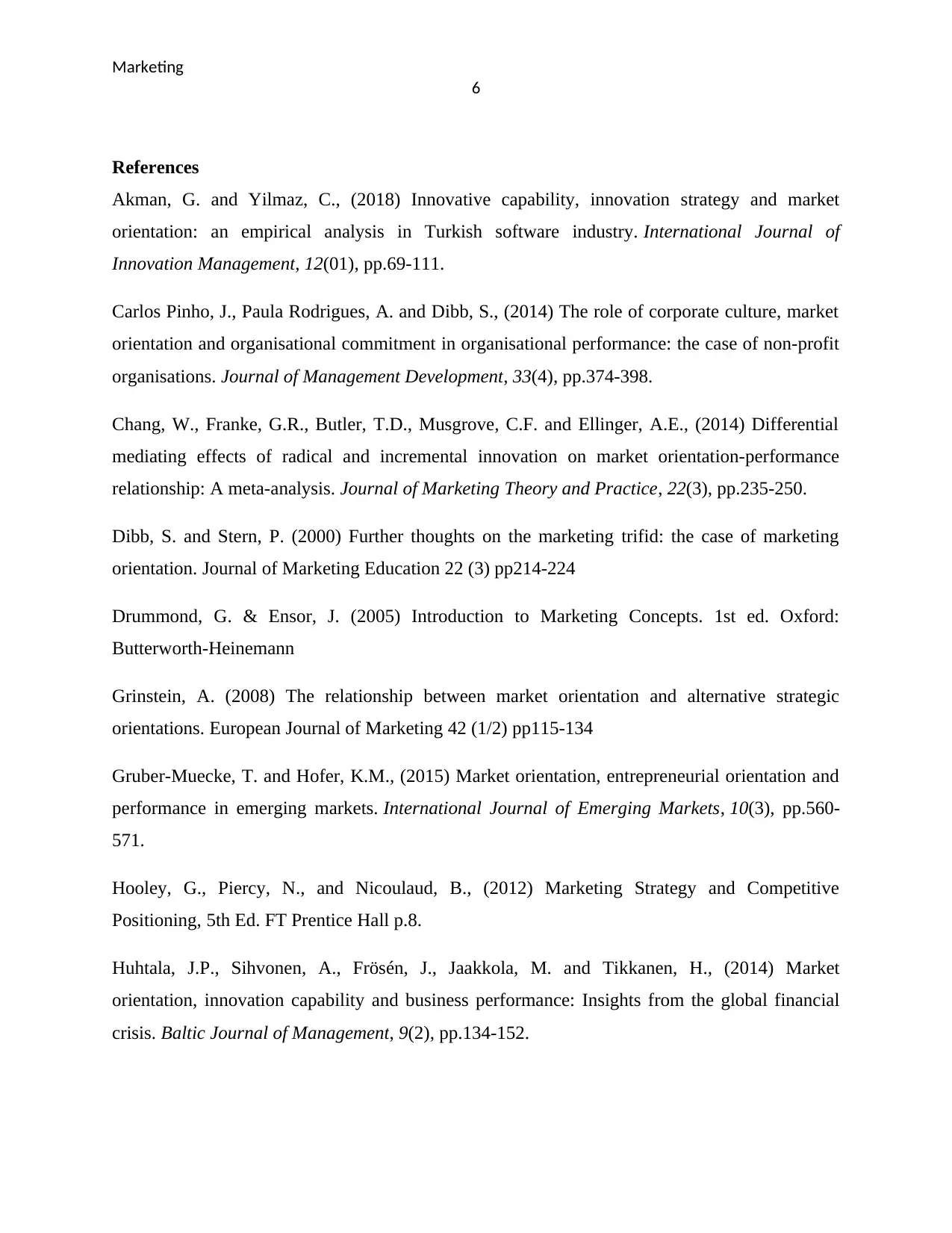
Marketing
6
References
Akman, G. and Yilmaz, C., (2018) Innovative capability, innovation strategy and market
orientation: an empirical analysis in Turkish software industry. International Journal of
Innovation Management, 12(01), pp.69-111.
Carlos Pinho, J., Paula Rodrigues, A. and Dibb, S., (2014) The role of corporate culture, market
orientation and organisational commitment in organisational performance: the case of non-profit
organisations. Journal of Management Development, 33(4), pp.374-398.
Chang, W., Franke, G.R., Butler, T.D., Musgrove, C.F. and Ellinger, A.E., (2014) Differential
mediating effects of radical and incremental innovation on market orientation-performance
relationship: A meta-analysis. Journal of Marketing Theory and Practice, 22(3), pp.235-250.
Dibb, S. and Stern, P. (2000) Further thoughts on the marketing trifid: the case of marketing
orientation. Journal of Marketing Education 22 (3) pp214-224
Drummond, G. & Ensor, J. (2005) Introduction to Marketing Concepts. 1st ed. Oxford:
Butterworth-Heinemann
Grinstein, A. (2008) The relationship between market orientation and alternative strategic
orientations. European Journal of Marketing 42 (1/2) pp115-134
Gruber-Muecke, T. and Hofer, K.M., (2015) Market orientation, entrepreneurial orientation and
performance in emerging markets. International Journal of Emerging Markets, 10(3), pp.560-
571.
Hooley, G., Piercy, N., and Nicoulaud, B., (2012) Marketing Strategy and Competitive
Positioning, 5th Ed. FT Prentice Hall p.8.
Huhtala, J.P., Sihvonen, A., Frösén, J., Jaakkola, M. and Tikkanen, H., (2014) Market
orientation, innovation capability and business performance: Insights from the global financial
crisis. Baltic Journal of Management, 9(2), pp.134-152.
6
References
Akman, G. and Yilmaz, C., (2018) Innovative capability, innovation strategy and market
orientation: an empirical analysis in Turkish software industry. International Journal of
Innovation Management, 12(01), pp.69-111.
Carlos Pinho, J., Paula Rodrigues, A. and Dibb, S., (2014) The role of corporate culture, market
orientation and organisational commitment in organisational performance: the case of non-profit
organisations. Journal of Management Development, 33(4), pp.374-398.
Chang, W., Franke, G.R., Butler, T.D., Musgrove, C.F. and Ellinger, A.E., (2014) Differential
mediating effects of radical and incremental innovation on market orientation-performance
relationship: A meta-analysis. Journal of Marketing Theory and Practice, 22(3), pp.235-250.
Dibb, S. and Stern, P. (2000) Further thoughts on the marketing trifid: the case of marketing
orientation. Journal of Marketing Education 22 (3) pp214-224
Drummond, G. & Ensor, J. (2005) Introduction to Marketing Concepts. 1st ed. Oxford:
Butterworth-Heinemann
Grinstein, A. (2008) The relationship between market orientation and alternative strategic
orientations. European Journal of Marketing 42 (1/2) pp115-134
Gruber-Muecke, T. and Hofer, K.M., (2015) Market orientation, entrepreneurial orientation and
performance in emerging markets. International Journal of Emerging Markets, 10(3), pp.560-
571.
Hooley, G., Piercy, N., and Nicoulaud, B., (2012) Marketing Strategy and Competitive
Positioning, 5th Ed. FT Prentice Hall p.8.
Huhtala, J.P., Sihvonen, A., Frösén, J., Jaakkola, M. and Tikkanen, H., (2014) Market
orientation, innovation capability and business performance: Insights from the global financial
crisis. Baltic Journal of Management, 9(2), pp.134-152.
Paraphrase This Document
Need a fresh take? Get an instant paraphrase of this document with our AI Paraphraser
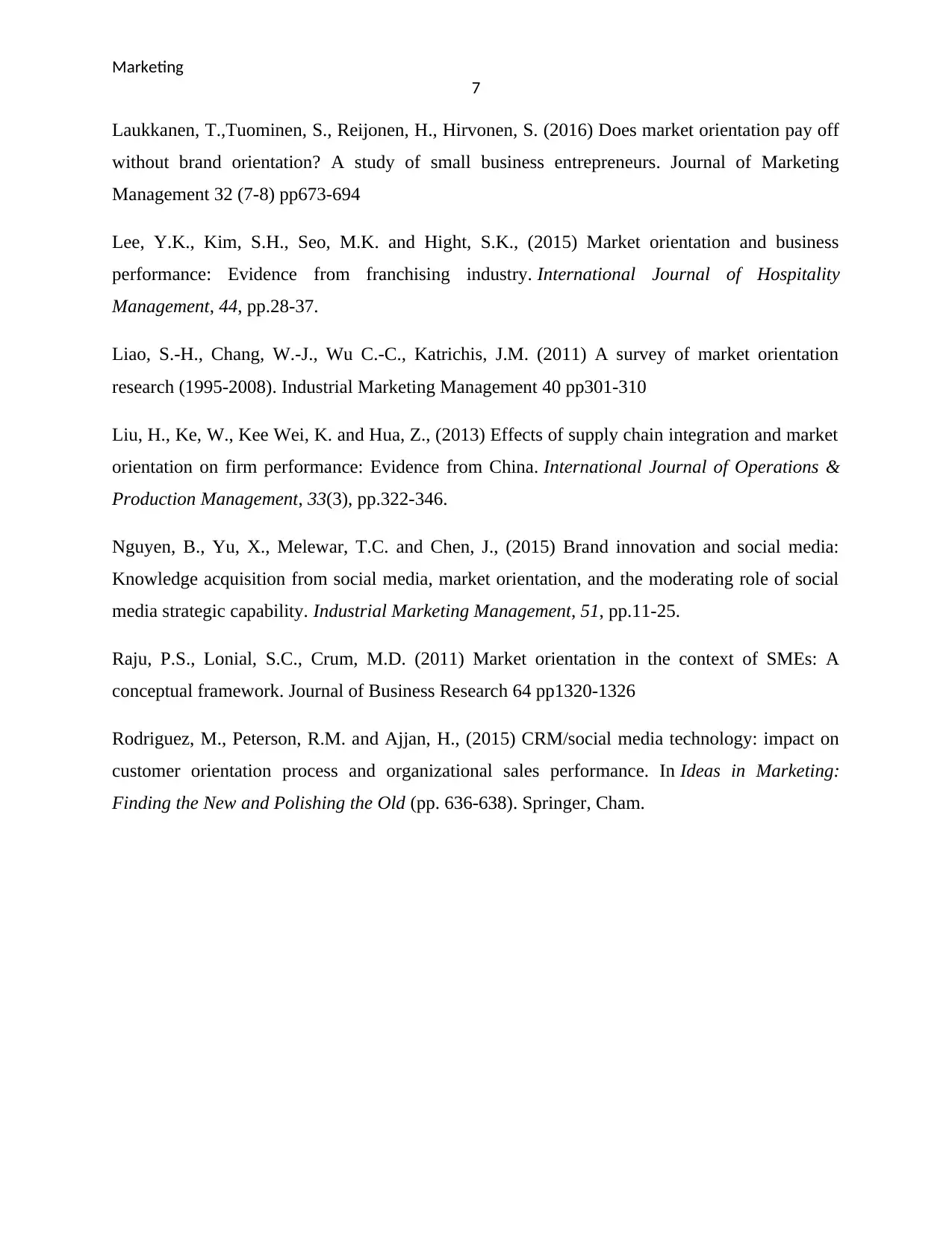
Marketing
7
Laukkanen, T.,Tuominen, S., Reijonen, H., Hirvonen, S. (2016) Does market orientation pay off
without brand orientation? A study of small business entrepreneurs. Journal of Marketing
Management 32 (7-8) pp673-694
Lee, Y.K., Kim, S.H., Seo, M.K. and Hight, S.K., (2015) Market orientation and business
performance: Evidence from franchising industry. International Journal of Hospitality
Management, 44, pp.28-37.
Liao, S.-H., Chang, W.-J., Wu C.-C., Katrichis, J.M. (2011) A survey of market orientation
research (1995-2008). Industrial Marketing Management 40 pp301-310
Liu, H., Ke, W., Kee Wei, K. and Hua, Z., (2013) Effects of supply chain integration and market
orientation on firm performance: Evidence from China. International Journal of Operations &
Production Management, 33(3), pp.322-346.
Nguyen, B., Yu, X., Melewar, T.C. and Chen, J., (2015) Brand innovation and social media:
Knowledge acquisition from social media, market orientation, and the moderating role of social
media strategic capability. Industrial Marketing Management, 51, pp.11-25.
Raju, P.S., Lonial, S.C., Crum, M.D. (2011) Market orientation in the context of SMEs: A
conceptual framework. Journal of Business Research 64 pp1320-1326
Rodriguez, M., Peterson, R.M. and Ajjan, H., (2015) CRM/social media technology: impact on
customer orientation process and organizational sales performance. In Ideas in Marketing:
Finding the New and Polishing the Old (pp. 636-638). Springer, Cham.
7
Laukkanen, T.,Tuominen, S., Reijonen, H., Hirvonen, S. (2016) Does market orientation pay off
without brand orientation? A study of small business entrepreneurs. Journal of Marketing
Management 32 (7-8) pp673-694
Lee, Y.K., Kim, S.H., Seo, M.K. and Hight, S.K., (2015) Market orientation and business
performance: Evidence from franchising industry. International Journal of Hospitality
Management, 44, pp.28-37.
Liao, S.-H., Chang, W.-J., Wu C.-C., Katrichis, J.M. (2011) A survey of market orientation
research (1995-2008). Industrial Marketing Management 40 pp301-310
Liu, H., Ke, W., Kee Wei, K. and Hua, Z., (2013) Effects of supply chain integration and market
orientation on firm performance: Evidence from China. International Journal of Operations &
Production Management, 33(3), pp.322-346.
Nguyen, B., Yu, X., Melewar, T.C. and Chen, J., (2015) Brand innovation and social media:
Knowledge acquisition from social media, market orientation, and the moderating role of social
media strategic capability. Industrial Marketing Management, 51, pp.11-25.
Raju, P.S., Lonial, S.C., Crum, M.D. (2011) Market orientation in the context of SMEs: A
conceptual framework. Journal of Business Research 64 pp1320-1326
Rodriguez, M., Peterson, R.M. and Ajjan, H., (2015) CRM/social media technology: impact on
customer orientation process and organizational sales performance. In Ideas in Marketing:
Finding the New and Polishing the Old (pp. 636-638). Springer, Cham.
1 out of 8
Related Documents
Your All-in-One AI-Powered Toolkit for Academic Success.
+13062052269
info@desklib.com
Available 24*7 on WhatsApp / Email
![[object Object]](/_next/static/media/star-bottom.7253800d.svg)
Unlock your academic potential
Copyright © 2020–2025 A2Z Services. All Rights Reserved. Developed and managed by ZUCOL.





